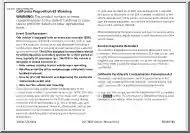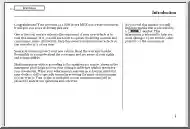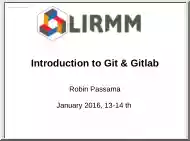No comments yet. You can be the first!
What did others read after this?
Content extract
Source: http://www.doksinet Thyroid/Anti-thyroid Drugs Source: http://www.doksinet Source: http://www.doksinet Thyroid Hormones Regulate: � Growth and development � Temperature and oxygen consumption � Metabolism of carbohydrate, protein, and lipid � Hypophyseal thyrotropin secretion (TSH) Source: http://www.doksinet Steps in the synthesis, storage, release and interconversion of thyroid hormones 1. Uptake of iodide ion (I-) by the gland (Sodiumiodide symporter (NIS)) 2. Oxidation of iodide and the iodonation of thyroglobulin 3. Coupling of iodotyrosine iodothyronines 4. Thyroglobulin colloid resorption from the lumen into the cell 5. Proteolysis of thyroglobulin (T3, T4) 6. Recycling of iodine (de-iodination) 7. Conversion of T4 to T3 Source: http://www.doksinet The hypothalamic-pituitary-thyroid axis • Acute psychosis or prolonged exposure to cold may activate the axis. • Hypothalamic TRH stimulates pituitary TSH release, while somatostatin and dopamine
inhibit it. • TSH stimulates T4 and T3 synthesis and release from the thyroid, and they in turn inhibit both TRH and TSH synthesis and release. • Small amounts of iodide are necessary for hormone production, but large amounts inhibit T3 and T4 production and release. • Solid arrows, stimulatory influence dashed arrows, inhibitory influence H, hypothalamus HP, anterior pituitary Source: http://www.doksinet Regulation Thyroid-pituitary Autoregulation of thyroid gland: iodine inhibits iodide organification Abnormal thyroid stimulators: TSH-R stim ab (lymphocytes in Graves disease), TSI Source: http://www.doksinet Biosynthesis of thyroid hormones Source: http://www.doksinet Iodine uptake � � � � Na+/I- symport protein controls serum I- uptake Based on Na+/K+ antiport potential Stimulated by TSH Inhibited by Perchlorate Source: http://www.doksinet Source: http://www.doksinet MIT / DIT formation � Thyroid Peroxidase (TPO) Apical membrane protein
Catalyzes Iodine organification to Tyrosine residues of Thyroglobulin Antagonized by methimazole � Iodine coupled to Thyroglobulin Monoiodotyrosine (Tg + one I-) Diiodotyrosine (Tg + two I-) � Pre-hormones secreted into follicular space Source: http://www.doksinet Major pathways of thyroid hormone biosynthesis and release Abbreviations: Tg, thyroglobulin; DIT, diiodotyrosine; MIT, monoiodotyrosine; TPO, thyroid peroxidase; HOI, hypoiodous acid; EOI, enzyme-linked species; D1 and D2, deiodinases; PTU, propylthiouracil; MMI, methimazole. Source: http://www.doksinet Regulation of transcription by thyroid hormones PB, plasma binding protein; F, transcription factor; R, receptor; PP, proteins that bind at the proximal promoter Source: http://www.doksinet Peripheral metabolism of thyroxine Source: http://www.doksinet Hormone Degredation � � � � T4 is converted to T3 (active) by 5’ deiodinase T4 can be converted to rT3 (inactive) by 5 deiodinase T3
is converted to rT2 (inactive) by 5 deiodinase rT3 is inactive but measured by serum tests Source: http://www.doksinet Source: http://www.doksinet Thyroid Hormone Majority of circulating hormone is T4 98.5% T4 1.5% T3 Total Hormone load is influenced by serum binding proteins (TBP, Albumin, ??) Thyroid Binding Globulin 70% Albumin 15% Transthyretin 10% Regulation is based on the free component of thyroid hormone Source: http://www.doksinet Iodine states � Normal Thyroid � Inactive Thyroid � Hyperactive Thyroid Source: http://www.doksinet Hormone Binding Factors � Increased TBG High estrogen states (pregnancy, OCP, HRT, Tamoxifen) Liver disease (early) � Decreased TBG Androgens or anabolic steroids Liver disease (late) � Binding Site Competition NSAID’s Furosemide IV Anticonvulsants (Phenytoin, Carbamazepine) Source: http://www.doksinet Wolff-Chaikoff effect � � � � Increasing
doses of I- increase hormone synthesis initially Higher doses cause cessation of hormone formation. This effect is countered by the Iodide leak from normal thyroid tissue. Patients with autoimmune thyroiditis may fail to adapt and become hypothyroid. Source: http://www.doksinet Jod-Basedow � Aberration of the Wolff-Chaikoff effect � Excessive iodine loads induce hyperthyroidism � Observed in several disease processes Graves’ disease Multinodular goiter Source: http://www.doksinet Hypothyroid � Cause is determined by geography � Diagnosis Low FT4, High TSH (Primary, check for antibodies) Low FT4, Low TSH (Secondary or Tertiary, TRH stimulation test, MRI) � Treatment Levothyroxine (T4) due to longer half life Treatment prevents bone loss, cardiomyopathy, myxedema Source: http://www.doksinet Hashimoto’s (Chronic, Lymphocytic) � � � � � Most common cause of hypothyroidism Result of antibodies to TPO, TBG Commonly presents in
females 30-50 yrs. Usually non-tender and asymptomatic Lab values High TSH Low T4 Anti-TPO Ab Anti-TBG Ab � Treat with Levothyroxine Source: http://www.doksinet Subacute Thyroiditis (DeQuervain’s, Granulomatous) � Acute viral infection of thyroid gland � Presents with viral prodrome, thyroid tenderness, and hyperthyroid symptoms � Lab values Variable TSH, T4 High ESR No antibodies � Treatment APAP, NSAID Prednisone (?) Levothyroxine (?) Source: http://www.doksinet Hypothyroidism � May result from variety of congenital disorders (with or without goiters) or iodine deficiency � Hashimoto’s thyroiditis-most common cause in U.SA (chronic autoimmune) � Characterized by decreased BMR, CO, fatigue, myxedema, lethargy, etc. Source: http://www.doksinet Hypothyroidism • Levothyroxine sodium (T4)-drug of choice. • L-T4 is given once daily because of long half life (goal: keep TSH in normal range) Steady state is
achieved at 6-8 weeks. • Toxicity is directly related to T4 levels (nervousness, heart palpitations and tachycardia, intolerance to heat, and weight loss). Source: http://www.doksinet Hypothyroidism � Myxedema coma: progressive weakness, stupor, hypothermia, hypoventilation, hypoglycaemia, hyponatremia, water intoxication, shock, death. � CO2 retention (decreased sensitivity of resp center) � Fluid and electrolyte imbalance with hyponatremia � Marked hypothermia (24C, 75 F) � Th. Iv Loading dose of levothyroxine 300-400 µg then daily 50 µg. + supportive care Source: http://www.doksinet Hypothyroidism Correction of myxedema (euthyroid state): cave CAD Myxedema coma: end stage of untreated hypothyroidism CO2 retention � hypoxia Fluid – electrolite imbalance (hyponatremia) Hypothermia (~24 C) Hypothyreosis and pregnancy: anovulatory cycles, thyroxine treatment is important Source: http://www.doksinet Source: http://www.doksinet Hypothyroid � Symptoms –
fatigability, coldness, weight gain, constipation, low voice � Signs – Cool skin, dry skin, swelling of face/hands/legs, slow reflexes, myxedema � Newborn – Retardation, short stature, swelling of face/hands, possible deafness � Types of Hypothyroidism Primary – Thyroid gland failure Secondary – Pituitary failure Tertiary – Hypothalamic failure Peripheral resistance Source: http://www.doksinet Pharmacokinetics •Both T4 and T3 are absorbed after oral administration. •T4 is converted to T3 by one of two distinct deiodinases, depending on tissue. •T3 binds to nuclear receptor •Hormones metabolized via P450 Source: http://www.doksinet Pharmacokinetics, cont. � Thus, drug-drug interactions occur with phenytoin, rifampin, carbamazepine � In liver, deaminated, decarboxylated, glucuronidated � In periphery, deiodinated Source: http://www.doksinet Pharmacokinetics, cont. •Normal plasma levels of T3 =0.1-015 ug/100 ul •T4 = 5-12 ug/100
ul •Free hormone is biologically active; metabolized faster •T1/2 of T4 = 7 days •T1/2 of T3 = 2 days (4 X more potent) Source: http://www.doksinet Source: http://www.doksinet Novel thyroid hormone analogues � Based on thyroid hormone receptor isoforms TRβ agonists (liver specific) reduce serum cholesterol level, anorectic effect TRα predominant in the heart � Thyromimetics with altered entry into cells Normally MCT8 (monocarboxylate transporter 8) T3 uptake MCT8 mutation (Allan-Herndon-Dudley sy.) DIPTA 3,5,diiodothyropropionic acid absorps MCT8 independently Source: http://www.doksinet Hyperthyroidism Source: http://www.doksinet Graves’ disease Source: http://www.doksinet Source: http://www.doksinet Graves � � � � � Most common cause of hyperthyroidism Result of anti-TSH receptor antibodies Diagnosis Symptoms of hyperthyroidism Clinical exopthalmos and goiter Low TSH, normal/high FT4, anti-TSH Ab (Optional) If no
clinical findings I123 may demonstrate increased uptake. Treatments Medical – Propothyouracil, Methimazole, Propranolol Surgical – Subtotal Thyroidectomy Radiation – RAI ablation [I131(Ci/g) x weight / %RAIU] Source: http://www.doksinet Source: http://www.doksinet Hyperthyroidism 1. Excessive amounts of thyroid hormones in the circulation are associated with Graves’ disease, toxic adenoma, goiter, and thyroiditis. 2. Goal of treatment is to reduce synthesis and/or release of hormone. 3. Accomplished by removing part or all of thyroid gland, or by blocking release of hormones from the follicle. Source: http://www.doksinet Hyperthyroidism • Inhibition of thyroid hormone synthesis: •by inactivating the peroxidase enzyme •blocks oxidative steps and condensation Source: http://www.doksinet Structure of thioamides The thiocarbamide moiety is shown in color. Source: http://www.doksinet Anti-thyroid Drugs •Thioamides are well absorbed via the gi
tract; short T1/2s. •PTU blocks deiodinase D1 in peripheral tissues; methimazole does not •Effects are slow in onset and thus drugs don’t work for thyroid storm. Source: http://www.doksinet Adverse effects � agranulocytosis (reversible) � rash (most common) � fever Source: http://www.doksinet Source: http://www.doksinet Source: http://www.doksinet Treatment of thyroid storm 1. Propranolol blunts sympathetic stimulation that occurs in hyperthyroidism. 2. Potassium iodide inhibits thyroid hormone release. 3. Large doses of propylthiouracil Source: http://www.doksinet Blockade of Hormone Release •Iodide is not useful for long-term therapy •Adverse effects: metallic taste in mouth, rashes, sore mouth Source: http://www.doksinet Anion inhibitors � � � � � Perchlorate ClO4Pertechnate TcO4Thiocyanate SCNBlock the uptake of I. Amiodarone-induced hyperthyroidism (KClO4) Source: http://www.doksinet Perchlorate � � � � ClO4- ion inhibits the
Na+ / Itransport protein. Normal individuals show no leak of I123 after ClO4- due to organification of I- to MIT / DIT Patients with organification defects show loss of RAIU. Used in diagnosis of Pendred syndrome Source: http://www.doksinet Iodine administration � � � � � � Iodinated contrast media Iopodate, iopanoic acid p.o Diatrizoate i.v In the treatment of hyperthyroidism Onset after 3 days Relatively non-toxic Source: http://www.doksinet Source: http://www.doksinet Radioactive Iodine � Used for scanning procedures � For multinodular hyperthyroidism and toxic adenomas � Isotope has short half life (radiation is expended within 56 days. � Beta particles act on parenchymal cells with little damage to surrounding tissue Source: http://www.doksinet Radioactive Iodine � NaI p.o storage follicles: beta rays, half life 5 days, 400-2000 µm penetration � Epithelial swelling, necrosis, follicular disruption, edema, leukocyte infiltration � Crosses
placenta and excreted in breast milk Source: http://www.doksinet Radioactive iodine � Available in solution or capsules � Chief disadvantages are high incidence of delayed hypothyroidism � Main contraindication is pregnancy Source: http://www.doksinet Source: http://www.doksinet Goiter � Endemic goiter Caused by dietary deficiency of Iodide Increased TSH stimulates gland growth Also results in cretinism � Goiter in developed countries Hashimoto’s thryoiditis Subacute thyroiditis � Other causes Excess Iodide (Amiodarone, Lithium) Adenoma, Malignancy Genetic / Familial hormone synthesis defects Source: http://www.doksinet Hyperthyroid � � � Symptoms – Palpitations, nervousness, fatigue, diarrhea, sweating, heat intolerance Signs – Thyroid enlargement (?), tremor Lab workup TSH FT4 RAIU � Other Labs Anti-TSH-R Ab, Anti-TPO Ab, Anti-TBG Ab FT3 FNA MRI, US Source: http://www.doksinet
Hyperthyroid � Common Causes *Graves Adenoma Multinodular Goiter *Subacute Thyroiditis *Hashimoto’s Thyroiditis � Rare Causes Thyrotoxicosis factitia, struma ovarii, thyroid metastasis, TSH-secreting tumor, hamburger Source: http://www.doksinet Hyperthyroidism Graves’ disease (diffuse toxic goiter) autoimmune disorder (supp T lymph defect) B cell � TSI Th.: Methimazole, propylthiouracil + thyroidectomy, + 131I +beta blocker (~120mg/d) + diltiazem (3 x 90-120 mg) Thyrotoxicosis factitia (Hamburger sy.) Source: http://www.doksinet
inhibit it. • TSH stimulates T4 and T3 synthesis and release from the thyroid, and they in turn inhibit both TRH and TSH synthesis and release. • Small amounts of iodide are necessary for hormone production, but large amounts inhibit T3 and T4 production and release. • Solid arrows, stimulatory influence dashed arrows, inhibitory influence H, hypothalamus HP, anterior pituitary Source: http://www.doksinet Regulation Thyroid-pituitary Autoregulation of thyroid gland: iodine inhibits iodide organification Abnormal thyroid stimulators: TSH-R stim ab (lymphocytes in Graves disease), TSI Source: http://www.doksinet Biosynthesis of thyroid hormones Source: http://www.doksinet Iodine uptake � � � � Na+/I- symport protein controls serum I- uptake Based on Na+/K+ antiport potential Stimulated by TSH Inhibited by Perchlorate Source: http://www.doksinet Source: http://www.doksinet MIT / DIT formation � Thyroid Peroxidase (TPO) Apical membrane protein
Catalyzes Iodine organification to Tyrosine residues of Thyroglobulin Antagonized by methimazole � Iodine coupled to Thyroglobulin Monoiodotyrosine (Tg + one I-) Diiodotyrosine (Tg + two I-) � Pre-hormones secreted into follicular space Source: http://www.doksinet Major pathways of thyroid hormone biosynthesis and release Abbreviations: Tg, thyroglobulin; DIT, diiodotyrosine; MIT, monoiodotyrosine; TPO, thyroid peroxidase; HOI, hypoiodous acid; EOI, enzyme-linked species; D1 and D2, deiodinases; PTU, propylthiouracil; MMI, methimazole. Source: http://www.doksinet Regulation of transcription by thyroid hormones PB, plasma binding protein; F, transcription factor; R, receptor; PP, proteins that bind at the proximal promoter Source: http://www.doksinet Peripheral metabolism of thyroxine Source: http://www.doksinet Hormone Degredation � � � � T4 is converted to T3 (active) by 5’ deiodinase T4 can be converted to rT3 (inactive) by 5 deiodinase T3
is converted to rT2 (inactive) by 5 deiodinase rT3 is inactive but measured by serum tests Source: http://www.doksinet Source: http://www.doksinet Thyroid Hormone Majority of circulating hormone is T4 98.5% T4 1.5% T3 Total Hormone load is influenced by serum binding proteins (TBP, Albumin, ??) Thyroid Binding Globulin 70% Albumin 15% Transthyretin 10% Regulation is based on the free component of thyroid hormone Source: http://www.doksinet Iodine states � Normal Thyroid � Inactive Thyroid � Hyperactive Thyroid Source: http://www.doksinet Hormone Binding Factors � Increased TBG High estrogen states (pregnancy, OCP, HRT, Tamoxifen) Liver disease (early) � Decreased TBG Androgens or anabolic steroids Liver disease (late) � Binding Site Competition NSAID’s Furosemide IV Anticonvulsants (Phenytoin, Carbamazepine) Source: http://www.doksinet Wolff-Chaikoff effect � � � � Increasing
doses of I- increase hormone synthesis initially Higher doses cause cessation of hormone formation. This effect is countered by the Iodide leak from normal thyroid tissue. Patients with autoimmune thyroiditis may fail to adapt and become hypothyroid. Source: http://www.doksinet Jod-Basedow � Aberration of the Wolff-Chaikoff effect � Excessive iodine loads induce hyperthyroidism � Observed in several disease processes Graves’ disease Multinodular goiter Source: http://www.doksinet Hypothyroid � Cause is determined by geography � Diagnosis Low FT4, High TSH (Primary, check for antibodies) Low FT4, Low TSH (Secondary or Tertiary, TRH stimulation test, MRI) � Treatment Levothyroxine (T4) due to longer half life Treatment prevents bone loss, cardiomyopathy, myxedema Source: http://www.doksinet Hashimoto’s (Chronic, Lymphocytic) � � � � � Most common cause of hypothyroidism Result of antibodies to TPO, TBG Commonly presents in
females 30-50 yrs. Usually non-tender and asymptomatic Lab values High TSH Low T4 Anti-TPO Ab Anti-TBG Ab � Treat with Levothyroxine Source: http://www.doksinet Subacute Thyroiditis (DeQuervain’s, Granulomatous) � Acute viral infection of thyroid gland � Presents with viral prodrome, thyroid tenderness, and hyperthyroid symptoms � Lab values Variable TSH, T4 High ESR No antibodies � Treatment APAP, NSAID Prednisone (?) Levothyroxine (?) Source: http://www.doksinet Hypothyroidism � May result from variety of congenital disorders (with or without goiters) or iodine deficiency � Hashimoto’s thyroiditis-most common cause in U.SA (chronic autoimmune) � Characterized by decreased BMR, CO, fatigue, myxedema, lethargy, etc. Source: http://www.doksinet Hypothyroidism • Levothyroxine sodium (T4)-drug of choice. • L-T4 is given once daily because of long half life (goal: keep TSH in normal range) Steady state is
achieved at 6-8 weeks. • Toxicity is directly related to T4 levels (nervousness, heart palpitations and tachycardia, intolerance to heat, and weight loss). Source: http://www.doksinet Hypothyroidism � Myxedema coma: progressive weakness, stupor, hypothermia, hypoventilation, hypoglycaemia, hyponatremia, water intoxication, shock, death. � CO2 retention (decreased sensitivity of resp center) � Fluid and electrolyte imbalance with hyponatremia � Marked hypothermia (24C, 75 F) � Th. Iv Loading dose of levothyroxine 300-400 µg then daily 50 µg. + supportive care Source: http://www.doksinet Hypothyroidism Correction of myxedema (euthyroid state): cave CAD Myxedema coma: end stage of untreated hypothyroidism CO2 retention � hypoxia Fluid – electrolite imbalance (hyponatremia) Hypothermia (~24 C) Hypothyreosis and pregnancy: anovulatory cycles, thyroxine treatment is important Source: http://www.doksinet Source: http://www.doksinet Hypothyroid � Symptoms –
fatigability, coldness, weight gain, constipation, low voice � Signs – Cool skin, dry skin, swelling of face/hands/legs, slow reflexes, myxedema � Newborn – Retardation, short stature, swelling of face/hands, possible deafness � Types of Hypothyroidism Primary – Thyroid gland failure Secondary – Pituitary failure Tertiary – Hypothalamic failure Peripheral resistance Source: http://www.doksinet Pharmacokinetics •Both T4 and T3 are absorbed after oral administration. •T4 is converted to T3 by one of two distinct deiodinases, depending on tissue. •T3 binds to nuclear receptor •Hormones metabolized via P450 Source: http://www.doksinet Pharmacokinetics, cont. � Thus, drug-drug interactions occur with phenytoin, rifampin, carbamazepine � In liver, deaminated, decarboxylated, glucuronidated � In periphery, deiodinated Source: http://www.doksinet Pharmacokinetics, cont. •Normal plasma levels of T3 =0.1-015 ug/100 ul •T4 = 5-12 ug/100
ul •Free hormone is biologically active; metabolized faster •T1/2 of T4 = 7 days •T1/2 of T3 = 2 days (4 X more potent) Source: http://www.doksinet Source: http://www.doksinet Novel thyroid hormone analogues � Based on thyroid hormone receptor isoforms TRβ agonists (liver specific) reduce serum cholesterol level, anorectic effect TRα predominant in the heart � Thyromimetics with altered entry into cells Normally MCT8 (monocarboxylate transporter 8) T3 uptake MCT8 mutation (Allan-Herndon-Dudley sy.) DIPTA 3,5,diiodothyropropionic acid absorps MCT8 independently Source: http://www.doksinet Hyperthyroidism Source: http://www.doksinet Graves’ disease Source: http://www.doksinet Source: http://www.doksinet Graves � � � � � Most common cause of hyperthyroidism Result of anti-TSH receptor antibodies Diagnosis Symptoms of hyperthyroidism Clinical exopthalmos and goiter Low TSH, normal/high FT4, anti-TSH Ab (Optional) If no
clinical findings I123 may demonstrate increased uptake. Treatments Medical – Propothyouracil, Methimazole, Propranolol Surgical – Subtotal Thyroidectomy Radiation – RAI ablation [I131(Ci/g) x weight / %RAIU] Source: http://www.doksinet Source: http://www.doksinet Hyperthyroidism 1. Excessive amounts of thyroid hormones in the circulation are associated with Graves’ disease, toxic adenoma, goiter, and thyroiditis. 2. Goal of treatment is to reduce synthesis and/or release of hormone. 3. Accomplished by removing part or all of thyroid gland, or by blocking release of hormones from the follicle. Source: http://www.doksinet Hyperthyroidism • Inhibition of thyroid hormone synthesis: •by inactivating the peroxidase enzyme •blocks oxidative steps and condensation Source: http://www.doksinet Structure of thioamides The thiocarbamide moiety is shown in color. Source: http://www.doksinet Anti-thyroid Drugs •Thioamides are well absorbed via the gi
tract; short T1/2s. •PTU blocks deiodinase D1 in peripheral tissues; methimazole does not •Effects are slow in onset and thus drugs don’t work for thyroid storm. Source: http://www.doksinet Adverse effects � agranulocytosis (reversible) � rash (most common) � fever Source: http://www.doksinet Source: http://www.doksinet Source: http://www.doksinet Treatment of thyroid storm 1. Propranolol blunts sympathetic stimulation that occurs in hyperthyroidism. 2. Potassium iodide inhibits thyroid hormone release. 3. Large doses of propylthiouracil Source: http://www.doksinet Blockade of Hormone Release •Iodide is not useful for long-term therapy •Adverse effects: metallic taste in mouth, rashes, sore mouth Source: http://www.doksinet Anion inhibitors � � � � � Perchlorate ClO4Pertechnate TcO4Thiocyanate SCNBlock the uptake of I. Amiodarone-induced hyperthyroidism (KClO4) Source: http://www.doksinet Perchlorate � � � � ClO4- ion inhibits the
Na+ / Itransport protein. Normal individuals show no leak of I123 after ClO4- due to organification of I- to MIT / DIT Patients with organification defects show loss of RAIU. Used in diagnosis of Pendred syndrome Source: http://www.doksinet Iodine administration � � � � � � Iodinated contrast media Iopodate, iopanoic acid p.o Diatrizoate i.v In the treatment of hyperthyroidism Onset after 3 days Relatively non-toxic Source: http://www.doksinet Source: http://www.doksinet Radioactive Iodine � Used for scanning procedures � For multinodular hyperthyroidism and toxic adenomas � Isotope has short half life (radiation is expended within 56 days. � Beta particles act on parenchymal cells with little damage to surrounding tissue Source: http://www.doksinet Radioactive Iodine � NaI p.o storage follicles: beta rays, half life 5 days, 400-2000 µm penetration � Epithelial swelling, necrosis, follicular disruption, edema, leukocyte infiltration � Crosses
placenta and excreted in breast milk Source: http://www.doksinet Radioactive iodine � Available in solution or capsules � Chief disadvantages are high incidence of delayed hypothyroidism � Main contraindication is pregnancy Source: http://www.doksinet Source: http://www.doksinet Goiter � Endemic goiter Caused by dietary deficiency of Iodide Increased TSH stimulates gland growth Also results in cretinism � Goiter in developed countries Hashimoto’s thryoiditis Subacute thyroiditis � Other causes Excess Iodide (Amiodarone, Lithium) Adenoma, Malignancy Genetic / Familial hormone synthesis defects Source: http://www.doksinet Hyperthyroid � � � Symptoms – Palpitations, nervousness, fatigue, diarrhea, sweating, heat intolerance Signs – Thyroid enlargement (?), tremor Lab workup TSH FT4 RAIU � Other Labs Anti-TSH-R Ab, Anti-TPO Ab, Anti-TBG Ab FT3 FNA MRI, US Source: http://www.doksinet
Hyperthyroid � Common Causes *Graves Adenoma Multinodular Goiter *Subacute Thyroiditis *Hashimoto’s Thyroiditis � Rare Causes Thyrotoxicosis factitia, struma ovarii, thyroid metastasis, TSH-secreting tumor, hamburger Source: http://www.doksinet Hyperthyroidism Graves’ disease (diffuse toxic goiter) autoimmune disorder (supp T lymph defect) B cell � TSI Th.: Methimazole, propylthiouracil + thyroidectomy, + 131I +beta blocker (~120mg/d) + diltiazem (3 x 90-120 mg) Thyrotoxicosis factitia (Hamburger sy.) Source: http://www.doksinet




 Just like you draw up a plan when you’re going to war, building a house, or even going on vacation, you need to draw up a plan for your business. This tutorial will help you to clearly see where you are and make it possible to understand where you’re going.
Just like you draw up a plan when you’re going to war, building a house, or even going on vacation, you need to draw up a plan for your business. This tutorial will help you to clearly see where you are and make it possible to understand where you’re going.